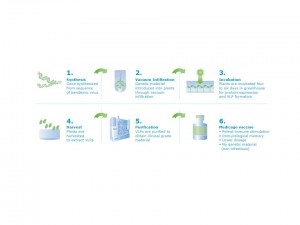Kugako Sugimoto, NOST Tokyo
Originally published on the site of NL Agency
Summary
Mitsubishi Chemical Holdings will start joint research with Medicago in Quebec, Canada to produce a new vaccine in a closed plant factory.
Details
Mitsubishi Chemical Holdings and Medicago in Canada will start joint research on the production of tobacco for new vaccines in closed plant factories. Mitsubishi has technology for a plant factory using LEDs. Medicago has technology to produce new vaccines by inserting genes into a relative of the tobacco plant. A closed plant factory will provide Medicago a more controllable environment than a greenhouse for the production of vaccines.
Medicago has greenhouse facilities in Quebec and is developing vaccines such as pandemic influenza, seasonal influenza, rabies, rotavirus etc. Tobacco is one variety of plants the company grows in greenhouses as the host in which targeted proteins for vaccine development are expressed. The new plant factory has a wind-resistant structure, sedimentation filtration system, and internal condition controls. External pollutants and insects are stopped by a series of screens. Using LEDs instead of sunlight will make tobacco grow faster because specific wave-lengths preferred by tobacco are provided.
Speed is important for vaccine production especially in the case of preparation for pandemic events such as influenza. When the World Health Organization (WHO) decides to address a new strain of Influenza, it takes about six months for the new vaccine to reach the market. Influenza patients cannot wait for such a long period. According to Medicago, using full grown living plants as hosts allows high expression of the targeted proteins in a short period. In addition, production of vaccines in plants is advantageous due to the easy production process and easy scale-up of facilities, compared to the traditional egg-based technology and other technologies using cell cultures, yeast, and bacteria.
Mechanisms to produce a vaccine by using tobacco starts from synthesis of a gene from the sequence of a virus (Fig 1). The synthesized genetic material is introduced into plants by vacuum filtration. Plants are incubated for four up to six days (currently) in a greenhouse for protein expression and virus-like-particles* (VLP) formation. Then VLPs are extracted from the plants and purified for a clinical use vaccine. A plant factory with LEDs and hydroponics would speed up the process by better controlling of e nvironments and excluding issues such as the length of night hours, intensity of light, and clouds.
nvironments and excluding issues such as the length of night hours, intensity of light, and clouds.
*Virus-like-particles (Wikipedia)
Sources







